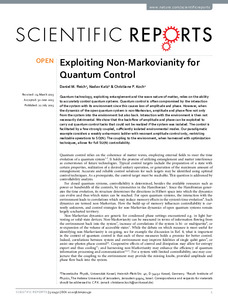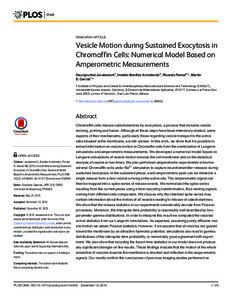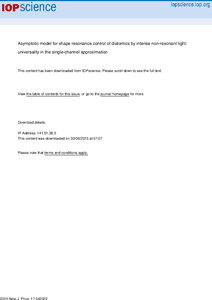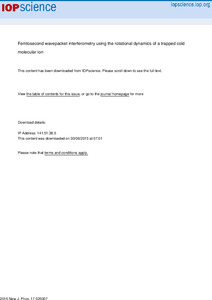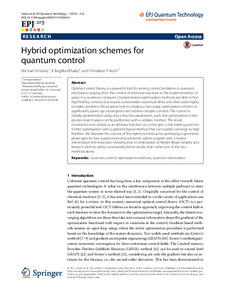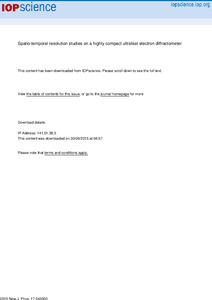Suche
Anzeige der Dokumente 1-7 von 7
Aufsatz
 Exploiting non-Markovianity for quantum control
Exploiting non-Markovianity for quantum control
(Nature Publishing Group, 2015)
Quantum technology, exploiting entanglement and the wave nature of matter, relies on the ability to accurately control quantum systems. Quantum control is often compromised by the interaction of the system with its environment since this causes loss of amplitude and phase. However, when the dynamics of the open quantum system is non-Markovian, amplitude and phase flow not only from the system into the environment but also back. Interaction with the environment is then not necessarily detrimental. We show that the ...
Aufsatz
 Vesicle motion during sustained exocytosis in chromaffin cells
Vesicle motion during sustained exocytosis in chromaffin cells
(PLoS, 2015)
Chromaffin cells release catecholamines by exocytosis, a process that includes vesicle docking, priming and fusion. Although all these steps have been intensively studied, some aspects of their mechanisms, particularly those regarding vesicle transport to the active sites situated at the membrane, are still unclear. In this work, we show that it is possible to extract information on vesicle motion in Chromaffin cells from the combination of Langevin simulations and amperometric measurements. We developed a numerical ...
Aufsatz
 Asymptotic model for shape resonance control of diatomics by intense non-resonant light: universality in the single-channel approximation
Asymptotic model for shape resonance control of diatomics by intense non-resonant light: universality in the single-channel approximation
(2015)
Non-resonant light interacting with diatomics via the polarizability anisotropy couples different
rotational states and may lead to strong hybridization of the motion. The modification of shape
resonances and low-energy scattering states due to this interaction can be fully captured by an
asymptotic model, based on the long-range properties of the scattering (Crubellier et al 2015 New J.
Phys. 17 045020). Remarkably, the properties of the field-dressed shape resonances in this asymptotic
multi-channel description ...
Aufsatz
 Asymptotic model for shape resonance control of diatomics by intense non-resonant light
Asymptotic model for shape resonance control of diatomics by intense non-resonant light
(2015)
We derive a universal model for atom pairs interacting with non-resonant light via the polarizability
anisotropy, based on the long range properties of the scattering. The corresponding dynamics can be
obtained using a nodal line technique to solve the asymptotic Schrödinger equation. It consists of
imposing physical boundary conditions at long range and vanishing the wavefunction at a position
separating the inner zone and the asymptotic region. We show that nodal lines which depend on the
intensity of the ...
Aufsatz
 Femtosecond wavepacket interferometry using the rotational dynamics of a trapped cold molecular ion
Femtosecond wavepacket interferometry using the rotational dynamics of a trapped cold molecular ion
(2015)
A Ramsey-type interferometer is suggested, employing a cold trapped ion and two time-delayed offresonant
femtosecond laser pulses. The laser light couples to the molecular polarization anisotropy,
inducing rotational wavepacket dynamics. An interferogram is obtained from the delay dependent
populations of the final field-free rotational states. Current experimental capabilities for cooling and
preparation of the initial state are found to yield an interferogram visibility of more than 80%. The
interferograms can ...
Aufsatz
 Hybrid optimization schemes for quantum control
Hybrid optimization schemes for quantum control
(Springer Open, 2015)
Optimal control theory is a powerful tool for solving control problems in quantum mechanics, ranging from the control of chemical reactions to the implementation of gates in a quantum computer. Gradient-based optimization methods are able to find high fidelity controls, but require considerable numerical effort and often yield highly complex solutions. We propose here to employ a two-stage optimization scheme to significantly speed up convergence and achieve simpler controls. The control is initially parametrized ...
Aufsatz
 Spatio-temporal resolution studies on a highly compact ultrafast electron diffractometer
Spatio-temporal resolution studies on a highly compact ultrafast electron diffractometer
(2015)
Time-resolved diffraction with femtosecond electron pulses has become a promising technique to directly provide insights into photo induced primary dynamics at the atomic level in molecules and solids. Ultrashort pulse duration as well as extensive spatial coherence are desired, however, space charge effects complicate the bunching of multiple electrons in a single pulse.Weexperimentally investigate the interplay between spatial and temporal aspects of resolution limits in ultrafast electron diffraction (UED) on our ...

